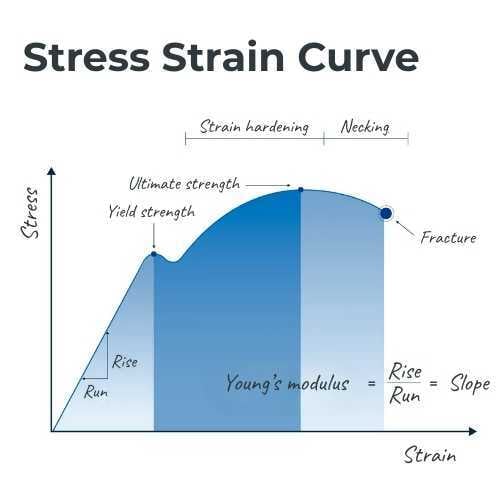Elasticity in Metals
Explore the fundamentals of elasticity in metals with this technical guide, covering critical material factors, modes of failure, measuring methods, and strategies for choosing the right metal for elastic applications.
Elasticity is a foundational mechanical property that defines how a material responds to stress and strain — specifically, its ability to return to its original shape after deformation.
In the context of CNC machining and mechanical design, elasticity plays a critical role in determining how a part will behave under load, how it will deflect, and how it will maintain dimensional stability over time.
This blog explores what elasticity is, how it’s measured, how it affects machining, and how engineers can strategically select elastic metals to design high-performance, manufacturable components.
What is Elasticity and Why it Matters
Elasticity refers to a material’s ability to deform under stress and return to its original shape once the stress is removed.
It is a measure of how “springy” or “stiff” a material is, and it’s quantified by the modulus of elasticity, also known as Young’s modulus. This modulus is defined as the ratio of stress (force per unit area) to strain (deformation per unit length) in the linear, elastic region of a material’s stress-strain curve.

In metals, elasticity is crucial for ensuring that components can withstand operational loads without undergoing permanent deformation. For example, in aerospace or precision instrumentation, even slight elastic deflection can affect performance or alignment.
A high modulus of elasticity indicates a stiffer material that resists deformation, while a lower modulus suggests a more flexible material.
Understanding this property helps engineers predict how a part will behave under load and design accordingly to maintain structural integrity and functional performance.
Factors that Affect Elasticity
Several factors affect a metal’s elasticity, including composition, heat treatment, grain size, and work hardening.
Composition
The types and concentrations of alloying elements directly influence the atomic bonding forces within the material, which in turn affect its stiffness. For example, pure metals like copper and aluminum tend to have lower elastic moduli due to their relatively loose atomic structures, while alloying with elements like chromium, nickel, or molybdenum can increase stiffness.
Engineers must consider how the base metal and its alloying additions will impact the material’s ability to resist elastic deformation under load.
Heat Treatment
Heat treatment can significantly alter a metal’s elastic properties by changing its microstructure. Processes like annealing, normalizing, and tempering adjust the internal arrangement of atoms and relieve residual stresses, which can improve the uniformity of elastic response. Annealing, for instance, increases ductility and reduces hardness, which may slightly lower the modulus of elasticity but improve the material’s ability to recover from deformation without cracking.
Engineers should carefully specify heat treatment parameters to ensure the desired balance between elasticity and other mechanical properties.
Grain Size
While grain size is more commonly associated with strength and ductility, it also influences elasticity by affecting how uniformly stress is distributed across the material. Fine-grained metals tend to exhibit more consistent elastic behavior due to their uniform microstructure, which helps prevent localized deformation.
Coarse grains, on the other hand, may lead to uneven stress distribution and slightly reduced elastic performance, especially in precision applications where dimensional stability is key.
Work Hardening
Work hardening occurs when a metal is plastically deformed during forming or machining. This process increases dislocation density within the material, which can enhance strength but may also reduce its elastic range. A work-hardened metal may exhibit higher resistance to initial deformation, but its ability to return to its original shape after stress is removed can be compromised.
For machined parts, engineers should consider whether post-machining operations — such as stress relief or annealing — are needed to restore consistent elastic behavior and prevent distortion during service.
Modes of Failure in Elastic Metals
When discussing elasticity in metals, it’s important to understand how different types of failure can occur when a material is stressed beyond its elastic limit.
Plastic Deformation
Initially, metals exhibit elastic deformation, meaning they return to their original shape once the load is removed. This behavior is governed by the material’s modulus of elasticity, which defines its stiffness. However, if the stress exceeds the elastic threshold, the metal enters the plastic deformation phase.
At this point, the material undergoes permanent changes in shape, which, while not a fracture, constitutes a failure in terms of maintaining dimensional integrity—especially critical in precision-machined components.
Fracture
Beyond plastic deformation, metals may experience fracture, which can be either brittle or ductile.
Brittle fracture occurs with minimal plastic deformation and is often sudden and catastrophic, as seen in materials like cast iron.
Ductile fracture, on the other hand, involves noticeable stretching before the material ultimately breaks, which is typical of softer metals like aluminum or copper.
Buckling
Another failure mode linked to elasticity is elastic instability, commonly known as buckling. This occurs when slender or thin-walled structures under compressive loads deform laterally, even if the stress remains within the elastic range.
It’s a critical consideration in structural design, especially for aerospace and medical device components where space constraints often lead to thin geometries.
Creep
Creep is another time-dependent failure mode where metals deform slowly under constant stress, particularly at elevated temperatures.

Though the initial deformation may be elastic, prolonged exposure leads to permanent strain. This is a major concern in high-temperature environments such as turbine engines or sterilization equipment.
Fatigue
Lastly, fatigue failure arises from repeated cyclic loading. Even if each individual load is within the elastic range, the accumulation of microstructural damage over time can lead to crack initiation and eventual fracture.

This makes fatigue analysis essential for components subjected to vibration or rotation, such as shafts, fasteners, and surgical tools.
How Elasticity is Measured
Elasticity is measured using tensile testing, where a specimen is subjected to a controlled tensile force while its elongation is recorded.
The slope of the initial, linear portion of the stress-strain curve obtained from this test represents the Young’s modulus. This value is typically expressed in gigapascals (GPa) and varies significantly between materials — for instance, steel has a modulus around 200 GPa, while aluminum is closer to 70 GPa.

The process involves gripping a standardized specimen in a universal testing machine, applying a gradually increasing tensile load, and measuring the resulting elongation. The key is to capture the elastic region — the portion of the curve where deformation is reversible.
Once the material yields and enters plastic deformation, it no longer behaves elastically. This method is standardized under ASTM E111 and ISO 6892, ensuring consistency across industries.
In addition to tensile testing, dynamic mechanical analysis (DMA) can be used for more advanced applications, especially when evaluating temperature-dependent elastic behavior. DMA applies oscillating forces to a specimen and measures its response, providing insights into both elastic and viscoelastic properties. While more common in polymers, DMA can be applied to metals in research and high-precision applications where elastic performance under varying conditions is critical.
Elasticity in Commonly Machined Metals
Elasticity influences not only how a part performs in service but also how it behaves during machining. For example, metals with low elasticity (high stiffness) resist deflection during cutting, which can improve dimensional accuracy but may also increase tool wear.
Conversely, more elastic metals may deflect under cutting forces, requiring careful fixture design and slower feed rates to maintain tolerances.
|
Metal |
Young's Modulus (GPa) |
Machining Considerations |
|
Aluminum |
~70 |
Easy to machine; low stiffness can cause chatter in thin sections; sharp tools recommended. |
|
Copper |
~110 |
Good machinability; ductile and elastic; may require coolant to manage heat. |
|
Titanium |
~115 |
Tough to machine; elastic recovery can cause spring-back; use rigid setups and slow feeds. |
|
Stainless Steel |
~190 |
Moderate machinability; work hardening and spring-back are common; use coated tools. |
|
Carbon Steels |
~200 |
Generally good machinability; higher stiffness improves dimensional control. |
|
Tool Steels |
~210 |
Very stiff; excellent dimensional stability; requires high-speed tooling and coolant. |
How Elasticity Impacts Machining
Elasticity significantly influences how metals behave during CNC machining, affecting everything from tool wear to surface finish and overall machinability. When a metal has a low Young’s modulus—meaning it is more elastic—it tends to deflect more under cutting forces. This deflection can lead to dimensional inaccuracies, especially in thin-walled or slender parts.
For example, aluminum, known for its relatively low stiffness, is prone to chatter and vibration during machining. These vibrations can degrade surface finish and accelerate tool wear if not properly managed.
Tool Wear
On the other hand, metals with high stiffness, such as tool steels or certain stainless steels, resist deflection and maintain better dimensional stability during cutting. However, their rigidity often comes with increased hardness, which can lead to higher tool wear and the need for more robust tooling and cooling strategies.
The elastic recovery of some materials, like titanium alloys, can also cause spring-back during or after machining. This phenomenon can affect tolerances and may require compensation in tool paths or additional finishing passes to achieve the desired geometry.
Surface Finish
Surface finish is another area where elasticity plays a role. More elastic materials may not shear as cleanly under the cutting tool, leading to a rougher finish unless optimal parameters—such as feed rate, tool geometry, and stepover—are carefully controlled. For instance, a smaller stepover in finishing passes can help mitigate the effects of material spring-back and improve surface quality.
Machinability
In terms of machinability, materials with moderate elasticity and good thermal conductivity, like certain copper and aluminum alloys, are generally easier to machine. However, their tendency to deform elastically means that fixturing and support strategies must be carefully planned to avoid part movement during cutting.
Conversely, stiffer materials may be more challenging to cut but offer better predictability and repeatability in high-precision applications.
Choosing the Right Metal for Elastic Applications
When elasticity is a key performance requirement in a machined component, engineers should begin by clarifying the role it plays in the part’s function. This could mean ensuring the part flexes and returns to its original shape, or that it resists deflection under load to maintain dimensional accuracy.
Once the functional need is defined, the next step is to quantify the acceptable range of elastic deformation. This often involves calculating or simulating the stresses the part will encounter and determining the minimum Young’s modulus required to keep deflection within tolerances.
With those parameters in hand, engineers can begin matching material families to the elasticity profile they need. Metals like aluminum and copper offer high elasticity and are suitable for parts that need to flex or absorb energy.
On the other end of the spectrum, tool steels and tungsten alloys provide high stiffness and are ideal for components that must remain rigid under load. Within each family, specific alloys may vary, so it’s important to consult datasheets or supplier specifications to confirm the modulus values.
Machinability must also be considered alongside elasticity. More elastic materials may deflect during cutting, which can lead to chatter, poor surface finish, and dimensional inaccuracies. These issues can be mitigated with sharp tooling, rigid fixturing, and optimized cutting parameters. Stiffer materials, while easier to machine accurately, often require more robust tooling and cooling strategies due to their hardness and tendency to wear down cutting tools more quickly.
Surface finish and tolerance requirements are also influenced by elasticity. Materials with high elastic recovery may spring back slightly after cutting, which can affect final dimensions and surface quality. Engineers may need to adjust tool paths or apply finishing operations to compensate for this behavior.
Finally, the selection process should factor in cost, availability, and secondary properties like corrosion resistance or thermal conductivity. Balancing elasticity with these practical considerations ensures the chosen metal meets both performance and manufacturing goals.


Let's connect
Want to learn more about our CNC machining services? Schedule a time to speak with our team.
